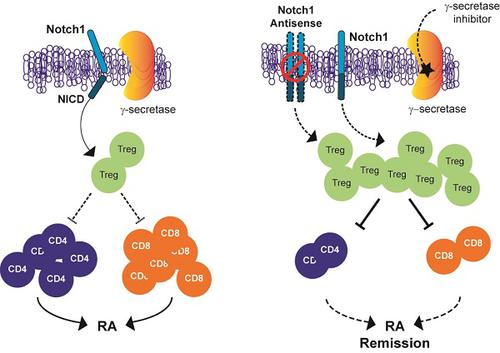Theranostics ( IF 12.4 ) Pub Date : 2018-09-09 , DOI: 10.7150/thno.26093 Bo Youn Choi , Yuri Choi , Jong-Sung Park , Li-Jung Kang , Seung Hyun Baek , Jin Su Park , Gahee Bahn , Yoonsuk Cho , Hark Kyun Kim , Jihoon Han , Jae Hoon Sul , Sang-Ha Baik , Dong Hoon Hyun , Thiruma V. Arumugam , Siyoung Yang , Jeung-Whan Han , Young Mo Kang , Yong-Woo Cho , Jae Hyung Park , Dong-Gyu Jo

|
Inhibition of Notch signalling has shown anti-inflammatory properties in vivo and in vitro models of rheumatoid arthritis (RA). The objective of this study was to determine whether Notch1 might play a role in regulating T-regulatory cells (Tregs) in animal models of RA.
Methods: Collagen-induced arthritis (CIA) and collagen antibody-induced arthritis (CAIA) were induced in C57BL/6, Notch1 antisense transgenic (NAS) or DBA1/J mice. We examined whether pharmacological inhibitors of γ-secretase (an enzyme required for Notch1 activation) and antisense-mediated knockdown of Notch1 could attenuate the severity of inflammatory arthritis in CIA and CAIA mice. Proportions of CD4+CD25+Foxp3+ Treg cells were measured by flow cytometry. To assess the suppressive capacity of Treg toward responder cells, CFSE-based suppression assay of Treg was performed.
Results: γ-secretase inhibitors and antisense-mediated knockdown of Notch1 reduced the severity of inflammatory arthritis in both CIA and CAIA mice. Pharmacological and genetic inhibition of Notch1 signalling induced significant elevation of Treg cell population in CIA and CAIA mice. We also demonstrated that inhibition of Notch signalling suppressed the progression of inflammatory arthritis through modulating the expansion and suppressive function of regulatory T (Treg) cells.
Conclusion: Pharmacological and genetic inhibition of Notch1 signalling suppresses the progression of inflammatory arthritis through modulating the population and suppressive function of Treg cells in animal models of RA.
Keywords: rheumatoid arthritis, Notch1, Treg, CIA, CAIA, γ-secretase
中文翻译:

Notch1的抑制诱导炎性关节炎的人口和调节性T细胞的抑制活性
Notch信号的抑制已在类风湿关节炎(RA)的体内和体外模型中显示出抗炎特性。这项研究的目的是确定Notch1是否在RA动物模型中可能在调节T调节细胞(Tregs)中发挥作用。
方法:在C57BL / 6,Notch1反义转基因(NAS)或DBA1 / J小鼠中诱导胶原诱导的关节炎(CIA)和胶原抗体诱导的关节炎(CAIA)。我们检查了γ分泌酶(Notch1激活所需的一种酶)的药理抑制剂和Notch1的反义介导的敲低是否可以减轻CIA和CAIA小鼠中炎性关节炎的严重程度。通过流式细胞术测量CD4 + CD25 + Foxp3 + Treg细胞的比例。为了评估Treg对应答细胞的抑制能力,进行了基于CFSE的Treg抑制测定。
结果: γ-分泌酶抑制剂和Notch1的反义介导的敲低降低了CIA和CAIA小鼠的炎性关节炎的严重程度。Notch1信号的药理和遗传抑制可导致CIA和CAIA小鼠Treg细胞数量显着增加。我们还证明了对Notch信号的抑制通过调节调节性T(Treg)细胞的扩增和抑制功能而抑制了炎症性关节炎的发展。
结论: Notch1信号传导的药理和遗传抑制作用通过调节RA动物模型中Treg细胞的数量和抑制功能来抑制炎症性关节炎的发展。
关键词:类风湿关节炎,Notch1,Treg,CIA,CAIA,γ-分泌酶











































 京公网安备 11010802027423号
京公网安备 11010802027423号